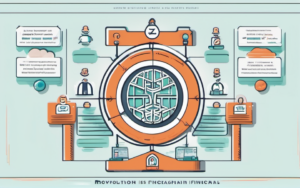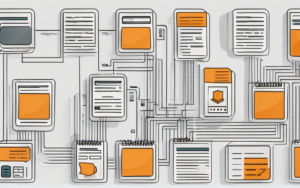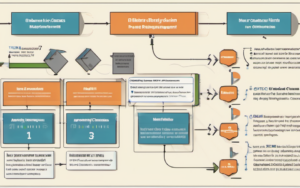The future of blockchain technology is brimming with potential, promising to reshape industries and redefine how we interact with digital systems. This exploration delves into the exciting possibilities and challenges awaiting us as we move further into the next decade and beyond, offering a glimpse into the blockchain future.
1. The Evolution of Blockchain Technology
The initial perception of blockchain was largely confined to cryptocurrencies like Bitcoin. However, the blockchain future extends far beyond this limited view. We’re witnessing a rapid evolution, marked by significant advancements in its core technology. This isn’t just about faster transactions; it’s about fundamentally changing how data is managed and secured.
The next ten years will see a dramatic increase in the sophistication of blockchain technology. We can anticipate more efficient consensus mechanisms, improved scalability, and enhanced security features, making it suitable for a wider range of applications beyond simple cryptocurrency transactions. This will involve significant improvements in the speed and cost-effectiveness of transactions.
1.1 Beyond Cryptocurrencies: Exploring New Applications
Blockchain’s capabilities transcend the realm of digital currencies. Its decentralized and transparent nature makes it ideally suited for applications in various sectors, from supply chain management to healthcare. Think about tracking pharmaceuticals from manufacturing to patient, ensuring authenticity and preventing counterfeiting. Or consider secure digital identity verification, eliminating the need for centralized authorities and enhancing privacy. The potential applications are vast and largely unexplored. We are only beginning to scratch the surface of what blockchain can achieve. This opens doors for innovative solutions that improve efficiency, security, and trust across numerous industries.
The versatility of the blockchain is constantly being revealed. Its inherent properties make it uniquely suited for solving problems in diverse areas where trust and transparency are paramount. This leads to the development of new business models and disruptive technologies.
1.2 Enhanced Scalability and Interoperability Solutions
One of the major challenges facing widespread blockchain adoption is scalability. Current systems struggle to handle the volume of transactions required for mass adoption. However, advancements are being made in this area. We’re seeing the development of Layer-2 solutions, such as state channels and sidechains, which significantly enhance transaction throughput without compromising the security of the main blockchain. The future of blockchain hinges on addressing these scalability issues effectively. This increased efficiency will accelerate the adoption of blockchain technology across various sectors.
Interoperability is another critical area. Different blockchains often operate in isolation, limiting their usefulness. Future developments will focus on creating seamless interoperability between different blockchain networks, allowing data and value to flow freely across systems. This will unleash the full potential of blockchain technology.
1.3 The Rise of Layer-2 Solutions and Their Impact
Layer-2 solutions are becoming increasingly crucial for scaling blockchain networks. These solutions process transactions off the main blockchain, reducing congestion and improving speed. Examples include Lightning Network for Bitcoin and Plasma for Ethereum. The impact is significant: faster transaction times, lower fees, and increased scalability, making blockchain technology more accessible and practical for everyday use. As these solutions mature and become more widely adopted, we can expect a significant boost in blockchain’s overall performance.
The development and implementation of Layer-2 solutions will be a defining characteristic of the next decade in the blockchain space. This will be crucial for widespread adoption and the realization of its full potential in various applications.
1.4 Advancements in Consensus Mechanisms and Security Protocols
The security and efficiency of a blockchain are largely determined by its consensus mechanism. While Proof-of-Work (PoW) has been dominant, we’re witnessing a shift towards more energy-efficient alternatives like Proof-of-Stake (PoS) and other innovative mechanisms. These advancements not only improve efficiency but also enhance the security and resilience of blockchain networks. The blockchain future depends heavily on continued innovation in this field.
Further advancements will likely focus on improving the resilience of blockchain networks against attacks. This includes developing more sophisticated security protocols and enhancing the robustness of the underlying cryptographic algorithms. The goal is to create a truly tamper-proof and secure system.
2. Blockchain’s Impact on Various Industries
The transformative power of blockchain extends far beyond the financial sector. Its impact on various industries is expected to be profound in the coming years.
2.1 Revolutionizing Supply Chain Management
Blockchain technology offers the potential to revolutionize supply chain management by providing a transparent and immutable record of goods’ journey from origin to consumer. This enhances traceability, combats counterfeiting, and optimizes logistics. For example, a company can track its products throughout the supply chain, ensuring quality and preventing fraud. This transparency builds trust with consumers and enhances efficiency across the entire process. The blockchain future in this space is bright, promising significant improvements in efficiency and trust. This has significant implications for businesses and consumers alike. The impact of blockchain on supply chain management in the next 10 years will be transformative.
2.2 Transforming the Healthcare Sector
The healthcare industry stands to benefit greatly from blockchain’s secure and transparent data management capabilities. Imagine a system where patient medical records are securely stored and shared, ensuring privacy while facilitating efficient access for authorized healthcare providers. This reduces administrative burden, improves data integrity, and strengthens patient trust. Blockchain technology also has the potential to streamline clinical trials and improve drug supply chain management. Furthermore, the use of blockchain in healthcare can improve efficiency and reduce costs, leading to better patient outcomes.
2.3 Reshaping the Financial Industry: Decentralized Finance (DeFi)
Decentralized finance (DeFi) is already transforming the financial industry, offering alternatives to traditional financial services. Blockchain enables the creation of decentralized applications (dApps) that provide lending, borrowing, and trading services without intermediaries. This increases accessibility and efficiency, but also poses challenges related to regulation and risk management. The impact of blockchain on decentralized finance in the next 10 years promises to be substantial, reshaping traditional financial institutions and creating new opportunities.
2.4 Blockchain’s Role in Digital Identity and Data Privacy
One of the most promising applications of blockchain is in the realm of digital identity. It offers a secure and decentralized way to manage and verify identities, protecting user privacy while simplifying authentication processes. This is particularly relevant in today’s increasingly digital world where data breaches are common. Blockchain’s role in digital identity verification in the future will be crucial, offering a more secure and private alternative to traditional methods. This will have profound implications for online security and privacy.
2.5 Impact on Voting Systems and Governance
Blockchain’s transparency and immutability make it a potential solution for improving voting systems. A blockchain-based voting system could enhance security, reduce fraud, and increase voter confidence. This is particularly relevant in regions where election integrity is a concern. Blockchain can also be used to improve governance by enhancing transparency and accountability in public institutions. This could lead to more efficient and participatory governance models.
3. Addressing the Challenges and Concerns
Despite its immense potential, the widespread adoption of blockchain technology faces several challenges.
3.1 Regulatory Hurdles and Legal Frameworks
The lack of clear regulatory frameworks for blockchain technology is a significant barrier to its adoption. Governments around the world are grappling with how to regulate cryptocurrencies and other blockchain-based applications. The absence of clear legal frameworks creates uncertainty and hinders investment. Addressing regulatory hurdles and establishing clear legal frameworks will be crucial for the growth of the blockchain ecosystem. This requires international collaboration and a nuanced approach that balances innovation with risk mitigation. The potential challenges and opportunities for blockchain adoption in the next decade are heavily influenced by regulatory developments.
3.2 Environmental Concerns and Energy Consumption
Some blockchain networks, particularly those using Proof-of-Work consensus mechanisms, consume significant amounts of energy. This raises environmental concerns. The development of more energy-efficient consensus mechanisms is crucial for addressing this challenge. This will require continued research and innovation in the field of blockchain technology. The environmental impact of blockchain technology is a crucial factor in its long-term sustainability.
3.3 Security Risks and Vulnerabilities
While blockchain technology is inherently secure, it’s not invulnerable to attacks. Smart contracts, for instance, can contain vulnerabilities that can be exploited by malicious actors. Continuous improvement in security protocols and the development of robust auditing mechanisms are essential for mitigating these risks. The security of blockchain systems is paramount for their widespread adoption. Ongoing efforts to enhance security are crucial for building trust and confidence in the technology.
3.4 Scalability Issues and Transaction Speeds
As mentioned earlier, scalability remains a challenge for many blockchain networks. The ability to handle a large volume of transactions efficiently is crucial for mass adoption. Ongoing research and development in areas like Layer-2 solutions and improved consensus mechanisms are essential for addressing these scalability issues. The blockchain future depends on successfully tackling these scalability challenges to ensure widespread adoption across diverse sectors.
4. Emerging Trends and Predictions
Several emerging trends are shaping the future of blockchain technology.
4.1 The Metaverse and Blockchain Integration
The metaverse is poised to become a significant application area for blockchain technology. Blockchain can facilitate secure digital ownership, verifiable identity, and decentralized governance within virtual worlds. This integration will create new opportunities for virtual commerce, digital asset management, and immersive experiences. Blockchain technology will play a pivotal role in shaping the metaverse’s future, ensuring security and transparency within virtual environments.
4.2 The Growing Importance of NFTs and Digital Ownership
Non-fungible tokens (NFTs) are gaining popularity as a way to represent and manage digital ownership. Blockchain’s ability to create unique and verifiable tokens is transforming various sectors, from art and collectibles to gaming and digital identity. The growing importance of NFTs suggests a future where digital assets are securely owned and traded using blockchain technology. This has far-reaching implications for intellectual property rights and digital commerce.
4.3 Decentralized Autonomous Organizations (DAOs) and Governance
Decentralized Autonomous Organizations (DAOs) represent a new form of organizational structure enabled by blockchain technology. DAOs are governed by smart contracts, eliminating the need for centralized authority. This fosters transparency and participatory decision-making. The future of DAOs is promising, potentially revolutionizing how organizations operate and interact. The rise of DAOs marks a significant shift towards decentralized governance models.
4.4 The Potential of Web3 and Decentralized Applications (dApps)
Web3, often described as the decentralized web, is envisioned as a more user-centric and privacy-focused internet powered by blockchain technology. Decentralized applications (dApps) built on blockchain offer greater transparency, security, and user control. The potential of Web3 and dApps is vast, potentially disrupting traditional online services and empowering users. Web3 represents a significant paradigm shift in how the internet functions and interacts with users.
5. A Glimpse into the Future
The long-term potential of blockchain technology is undeniable. Its ability to create trust, transparency, and security in a digital world is transformative. However, realizing this potential requires collaboration and innovation across various stakeholders. Governments, businesses, and researchers must work together to address the challenges and unlock the opportunities presented by blockchain technology. This includes developing clear regulatory frameworks, fostering innovation in energy-efficient consensus mechanisms, and investing in security research. Preparing for a blockchain-powered future requires proactive engagement and a forward-thinking approach. The next decade will be crucial in shaping the trajectory of this revolutionary technology, ushering in a new era of decentralized systems and applications. The journey ahead is filled with both exciting possibilities and significant challenges, making it a fascinating space to watch and contribute to.




